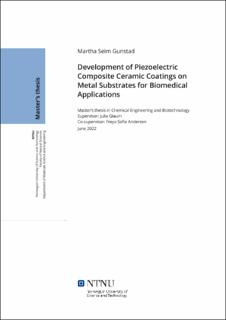| dc.contributor.advisor | Glaum, Julia | |
| dc.contributor.advisor | Andersen, Freya Sofia | |
| dc.contributor.author | Gunstad, Martha Seim | |
| dc.date.accessioned | 2022-09-13T17:19:37Z | |
| dc.date.available | 2022-09-13T17:19:37Z | |
| dc.date.issued | 2022 | |
| dc.identifier | no.ntnu:inspera:108213079:32364682 | |
| dc.identifier.uri | https://hdl.handle.net/11250/3017609 | |
| dc.description.abstract | Helbredelse av skadede ben kan forbedres ved å øke benveksten. Dette kan gjøres ved hjelp av elektrisk stimulering. Piezoelektriske implantatmaterialer er en mulighet for å oppnå denne stimuleringen. Piezoelektriske keramer har ikke de nødvendige mekaniske egenskapene for implantatmaterialer. På den andre siden har metaller de mekaniske egenskapene, men ikke de piezoelektriske egenskapene. Piezoelektriske belegg på metallsubstrater er derfor en måte å kombinere disse egenskapene. Keramer må generelt sintres ved høye temperaturer for å oppnå tilstrekkelig lav porøsitet. De høye temperaturene kan ha en negativ effekt på metallsubstratet. Ved å kombinere piezoelektriske keramer med porselen kan det være mulig å lage tette piezoelektriske belegg ved lavere temperaturer. Porselen smeltet til metall er et materialsystem som har blitt brukt til tannrestaureringer i flere tiår.
I denne masteroppgaven har to bariumtitanat pulver dopet med kalsium og zirkonium (BCZT) blitt kombinert med porselen for å lage BCZT/porselensbelegg på Ti-6Al-4V substrater. BCZT-pulverne har blitt fremstilt via faststoffsyntese, og to ulike partikkelstørrelser ble fremstilt. Effekten av ulike mengder og partikkelstørrelser av BCZT-pulver på disse beleggene har blitt undersøkt. Prosedyren som er blitt brukt til å lage beleggene har tatt utgangspunkt i metodene tannteknikere bruker når de jobber med porselen på metall.
Porøsiteten i BCZT/porselensbeleggene økte med økt mengde BCZT-pulver. Mindre BCZT-partikler resulterte i flere porer enn det større BCZT-partikler gjorde. Bindingsstyrken var høyest for beleggene med 40 vt% BCZT-pulver. Den dielektriske responsen forbedret seg med økende mengde BCZT-pulver. Det var imidlertid ikke mulig å måle den piezoelektriske responsen til beleggene.
Prosedyren for å lage beleggene og materialsystemet kan forbedres. Dette kan lede til økt bindingsstyrke og forbedrede piezoelektriske egenskaper i beleggene. Resultatene av denne oppgaven er likevel lovende for bruk av BCZT/porselensbelegg til implantatmaterialer. | |
| dc.description.abstract | The healing of damaged bones can be promoted by increasing the bone growth using electrical stimulation. This electrical stimulation can be applied by using piezoelectric implant materials. Piezoelectric ceramics lack the mechanical properties necessary for implant materials. On the other hand, metallic implants have the mechanical properties but lack the piezoelectric properties of the ceramics. Piezoelectric coatings on metal substrates are therefore considered in order to combine these properties. However, densification of ceramics requires high temperatures, which can damage the metal substrates. Combining the piezoelectric ceramic with dental porcelains is thought the make dense piezoelectric coatings possible at lower temperatures. This is because dental porcelains fused to metals is a system which has been successfully used for dental restorations for decades.
In this study, two calcium and zirconium doped barium titanate (BCZT) powders have been used together with dental porcelains to prepare BCZT/porcelain coatings on Ti-6Al-4V substrates. The BCZT powders have been prepared through solid-state synthesis, resulting in two powders of different particle sizes. The effect of different amounts and different particle sizes of BCZT on the coatings have been evaluated. The procedure used for dental restorations in porcelains on metal has been adapted for the preparation of these coatings.
The porosity of the BCZT/porcelain coatings increased as the amount of BCZT powder was increased. Smaller BCZT particles resulted in a higher amount of pores compared to larger particles. The bond strength of the coatings was found to be highest for coatings with 40 wt% BCZT powder. The dielectric response of the coatings improved with increasing amounts of BCZT powder. However, it was not possible to measure the piezoelectric response of these coatings.
Further improvements can be made to the coating procedure and the material system. This can increase the bond strength and piezoelectric properties of the coatings. Still, these results are promising for the use of BCZT/porcelain coatings for implant materials. | |
| dc.language | eng | |
| dc.publisher | NTNU | |
| dc.title | Development of Piezoelectric Composite Ceramic Coatings on Metal Substrates for Biomedical Applications | |
| dc.type | Master thesis | |
